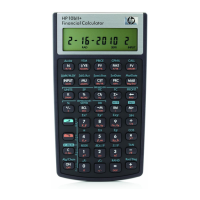6. (Hold) ON N FV 0.00 Press and hold down ON, N,
and FV. When you release all
three, memory is cleared and
all functions revert to original
factory settings.
7. OS CL
?
. 0.00 Clears statistical memory.
8. OS DISP (0 through 9) or (.) Selecting 0 through 9 will set
the number of decimal places
displayed to the number
selected. Selecting (.) will
cause the number of decimal
places displayed to “float.”
B. Using the memory capability:
The HP 10BII can store numbers for re-use in several different ways:
?? Use the (K) or constant key to store a number and its operator for repetitive operations.
?? Use the 3 key memory [(? M), (RM), and (M+)] to store, recall, and sum numbers respectively.
?? Use (OS) (STO) and (RCL) to store to, and recall from, the 10 numbered registers.
Using Constants: Use (K) to store a number and arithmetic operator for repetitive calculations.
Example: Calculate 5 + 2, 6 + 2, and 7 + 2.
Keystrokes Display Description
1. (5) (+) (2) (K) 2.00 Stores “+2” as constant.
2. (=) 7.00 Adds 5 + 2.
3. (6) (=) 8.00 Adds 6 + 2.
4. (7) (=) 9.00 Adds 7 + 2.
Using the M Register: The (?M), (RM), and (M+) keys perform memory operations in a single
storage register called the M register. Although it generally is unnecessary to clear the M register, it
can be cleared by pressing (0) (?M). To add a series of number to the M register, use (?M) to store
the first number and (M+) to add subsequent numbers. To subtract numbers from the M register,
press (+/-).

